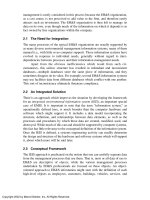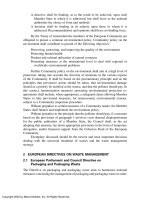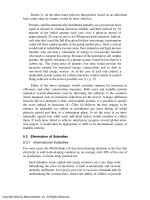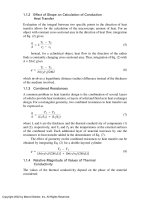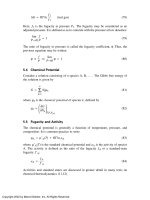Control and measurement of clamping and machining forces in intelligent fixturing
Bạn đang xem bản rút gọn của tài liệu. Xem và tải ngay bản đầy đủ của tài liệu tại đây (822.27 KB, 95 trang )
CONTROL AND MEASUREMENT OF CLAMPING AND
MACHINING FORCES IN INTELLIGENT FIXTURING
RAWTHER ASHIQUL HAMEED
(B.Eng.(Hons.), NUS)
A THESIS SUBMITTED FOR
THE DEGREE OF MASTER OF ENGINEERING
DEPARTMENT OF MECHANICAL ENGINEERING
NATIONAL UNIVERSITY OF SINGAPORE
2003
ACKNOWLEDGEMENTS
I would like to express my sincere gratitude to my supervisors Associate Professor M.A.
Mannan and Professor A.Y.C. Nee who shared their wealth of knowledge and research
expertise and constantly helped me with their insightful advice and seemingly endless
research ideas that made my stint under them a truly learning and enriching experience.
Being a novice to research and struggling to meet their globally acclaimed standards and
excellence, their friendly spirit, support and rapport have been a real source of motivation
and enhancement of my research acumen. It was truly a great opportunity and rewarding
experience to have worked under them.
I would express my appreciation and gratitude to Mr SC Lim, Mr CS Lee and Mr CH Tan
for their support with all the experimental work needed for this research. Their friendly
gesture and air of informality made the experimental part of this work as light as it could
get.
i
TABLE OF CONTENTS
Acknowledgements
i
Table of Contents
ii
List of Figures
v
List of Tables
Summary
viii
ix
CHAPTER 1 INTRODUCTI ON .........................................................................................1
1.1 RESEARCH M OTIVATION ..............................................................................................2
1.3 ORGANISATION OF THE THESIS ....................................................................................4
CHAPTER 2 LITERATURE REVIEW.............................................................................5
2.1 BASIC FIXTURE D ESIGN ...............................................................................................5
2.2 LOCATING PRINCIPLE ..................................................................................................5
2.3 REQUIREMENTS OF A FIX TURE.....................................................................................6
2.4 BASIC CLAMPING FORCE CONTROL ............................................................................8
2.5 FIXTURE HARDWARE DEVELOPMENT .........................................................................9
2.6 CUTTING FORCE M ODELS AND CUTTING FORCE M EASUREMENT ...........................10
2.7 DYNAMIC FORCE M EASUREMENT .............................................................................12
2.8 FIXTURE M ODELS AND D EVELOPMENTS ...................................................................13
2.9 EFFECT OF FRICTION IN FIXTURING..........................................................................15
ii
CHAPTER 3 CUTTING FORCE MEASUREMENT IN A FIXTURING SET-UP WITH
INSTRUMENTED LOCATORS ......................................................................................17
3.1 INTRODUCTION ...........................................................................................................17
3.2 STABILITY ANALYSIS ..................................................................................................21
3.3 FORCE DISTRIBUTION IN END - MILLING ....................................................................22
3.4 RELATIONSHIP BETWEEN CUTTING, CLAMPING, LOCATOR AND FRICTIONAL FORCES
...........................................................................................................................................24
3.5 DETERMINATION OF THE CUTTING FORCES .............................................................26
3.6 EXPERIMENTAL PROCEDURE .....................................................................................27
3.6.1 Instrumented Locators........................................................................................27
3.6.2 Experimental Set -up ...........................................................................................29
3.7 RESULTS AND ANALYSIS .............................................................................................30
3.7.1 Analysis of Engagement time .............................................................................34
3.7.2 Quantitative Analysis with the Model Developed Based on Planar Stability Analysis
.......................................................................................................................................34
3.8 PERFORMANCE ANALYSIS ..........................................................................................43
3.9 ADVANTAGES WITH THE D EVELOPED M EASURING S YSTEM ....................................44
3.10 DISADVANTAGES OF THE D EVELOPED S YSTEM.......................................................45
CHAPTER 4 FORCE MEASUREMENT IN A DYNAMOMETER OUTSIDE
ASSOCIATED WORKSPACE ENVELOPE ..................................................................47
4.1 INTRODUCTION ...........................................................................................................47
4.2 STATIC LOADING TEST FOR THE D YNAMOMETER ....................................................47
iii
CHAPTER 5 DEVELOPMENT OF A CLAMPING ELEM ENT USING DIRECTTORQUE CONTROL ........................................................................................................52
5.1 INTRODUCTION ...........................................................................................................52
5.2 DIRECT TORQUE CONTROL OF DC M OTOR ..............................................................53
5.3 CONTROL M ECHANISM ..............................................................................................54
5.4 M ECHANICAL S YSTEM ...............................................................................................56
CHAPTER 6 OPTIMISATION OF MINIMUM CLAMPING FORCE.......................59
6.1 INTRODUCTION ...........................................................................................................59
6.2 ALGORITHM FOR OPTIMISATION ...............................................................................60
6.3 EXPERIMENTAL S ET- UP ..............................................................................................61
6.3 OPTIMISATION TECHNIQUE USING LINEAR PROGRAMMING....................................62
6.4 OVERALL S YSTEM INTEGRATION ..............................................................................69
CHAPTER 7 CONCLUSIONS AND FUTURE WORK ................................................71
7.1 CONCLUSIONS .............................................................................................................72
7.2 CONTRIBUTIONS .........................................................................................................72
7.3 SCOPE FOR FUTURE WORK........................................................................................73
REFERENCES ...........................................................................................................................................................75
iv
LIST OF FIGURES
FIGURE 1.1 TYPICAL FIXTURE ASSEMBLY [CARR LANE 1995]..............................................1
FIGURE 2.1 THE 3-2-1 LOCATING PRINCIPLE [X IAO 1998] ...................................................6
FIGURE 3.1 FORCE PLATE (K ISTLER, 9253A) .....................................................................19
FIGURE 3.2 AN ILLUSTRATION OF LOADING OUTSIDE ENVELOPE......................................20
FIGURE 3.3 CUTTING AND CLAMPING FORCES [J ENG 1995] ..............................................22
FIGURE 3.4 CUTTING, CLAMPING AND LOCATOR FORCES ACTING ON A PRISMATIC PART 24
FIGURE 3.5 UNIAXIAL FORCE S ENSOR ......................... ERROR ! BOOKMARK NOT DEFINED.28
FIGURE 3.6 D ESIGN OF THE INSTRUMENTED LOCATOR WITH UNIAXIAL FORCE SENSOR ..28
FIGURE 3.7 EXPERIMENTAL SET- UP WITH THE LOCATORS AND CLAMPS PLACED ON THE
DYNAMOMETER ....................................................................................................29
FIGURE 3.8 SCHEMATIC DRAWING IN PLAN VIEW OF THE EXPERIMENTAL SET- UP ...........30
FIGURE 3.9 THE END MILLING OPERATION WITH THE ENGAGEMENT ANGLE SHOWN .......31
FIGURE 3.10 FORCE RECORDED FROM THE X-AXIS OUTPUT OF THE DYNAMOMETER ......32
FIGURE 3.11 FORCE RECORDED FROM CLAMP1, FAA .......................................................33
FIGURE 3.12 FORCE RECORDED FROM LOCATOR 1, FA.....................................................33
FIGURE 3.13 (A) FORCE DATA RECORDED FROM CLAMP FAA ...........................................35
FIGURE 3.13 (B) FORCE DATA RECORDED FROM CLAMP FAA ...........................................35
FIGURE 3.13 (C) FORCE DATA RECORDED FROM LOCATOR FA..........................................36
FIGURE 3.13 (D) FORCE DATA RECORDED FROM LOCATOR FB ..........................................36
FIGURE 3.13 ( E) FORCE DATA RECORDED FROM LOCATOR FC..........................................36
FIGURE 3.13 ( F) FORCE DATA RECORDED FROM LOCATOR FD ..........................................37
v
FIGURE 3.13 ( G) FORCE DATA RECORDED FROM LOCATOR FE..........................................37
FIGURE 3.13 ( H) FORCE DATA RECORDED FROM LOCATOR FF ..........................................37
FIGURE 3.13 ( I) FORCE DATA RECORDED FROM X-AXIS OF DYNAMOMETER .....................38
FIGURE 3.13 (J ) FORCE DATA RECORDED FROM Y-AXIS OF DYNAMOMETER .....................38
FIGURE 3.13 ( K) FORCE DATA RECORDED FROM Z-AXIS OF DYNAMOMETER ....................38
FIGURE 3.14 THE GEOMETRIC PARAMETERS FOR THE 3-2-1 LOCATOR SET - UP OF THE
WORKPIECE...........................................................................................................39
FIGURE 4.1 S ET- UP FOR STATIC LOADIN G ...........................................................................48
FIGURE 4.2 S ET- UP FOR STATIC LOADIN G ...........................................................................49
FIGURE 4.3 (A) FORCE ALONG THE Z-AXIS OF THE DYNAMOMETER ..................................50
FIGURE 4.3 (B) FORCE ALONG THE Y-AXIS OF THE DYNAMOMETER ..................................50
FIGURE 5.1 DC M OTOR- TORQUE CONTROLLER ................................................................55
FIGURE 5.2 M OTOR OPERATING CHARACTERISTICS .........................................................57
FIGURE 5.3 CALIBRATION GRAPH .......................................................................................58
FIGURE 6.1 OPTIMISATION SCHEME ...................................................................................60
FIGURE 6.2(A) PLAN VIEW OF THE SET - UP...........................................................................61
FIGURE 6.2(B) ISOMETRIC VIEW OF THE SET - UP .................................................................62
FIGURE 6.3 (A) COMPONENT OF CUTTING FORCE FT ..........................................................65
FIGURE 6.3 (B) COMPONENT OF CUTTING FORCE FF ..........................................................65
FIGURE 6.3 (C) COMPONENT OF CUTTING FORCE FA ..........................................................65
FIGURE 6.4 FORCE APPLIED BY CLAMP FBB.......................................................................66
FIGURE 6.5 FORCE APPLIED BY CLAMP FBB.......................................................................66
FIGURE 6.6 O UTPUT FROM THE OPTIMISATION SOLVER .....................................................68
FIGURE 6.6 SCHEMATIC REPRESENTATION OF THE SYSTEM INTEGRATION. ......................70
vi
LIST OF TABLES
TABLE 3.1 CUTTING DATA FOR THE EXPERIMENTS PERFORMED……………….40
TABLE 3.1 ERROR VALUES AS A PERCENTAGE OF MEASURED FORCE…………41
TABLE 3.3 RMS VALUE OF THE ERRORS……………………………….……………….42
vii
SUMMARY
Accuracy and precision are the most important aspects of any machining operation. This is
greatly dependent on the stability of the workpiece, which is in turn decided by the
effectiveness and performance of the workholding device. Workholding in any
manufacturing process is performed by the fixturing elements. Fixture design and
implementation is dependent on the forces acting on the workpiece, which are
predominantly the cutting and the clamping forces.
Every machining process, especially those that involve the control of the fixturing forces
in flexible manufacturing systems, require the measurement of clamping and cutting
forces. This research addresses pertinent issues in both cutting force measurements and
control of the clamping force and an attempt is made to solve the problems associated
with the existing systems. The study and development in this work include the following:
A novel force measurement technique in a fixturing arrangement with instrumented
locators has been developed. Earlier works on the study of the stability of the workpiece
with a spatial stability analysis is incorporated in this work to develop the force measuring
system. A detailed study and experimental investigation into the performance of the
dynamometer is carried out. The developed system aims to overcome some problems
associated with the dynamometer and provide a viable alternative for force measurement
in real time during a machining operation. There is no prior work to establish the
relationship between the forces obtained using the locators based on the 3-2-1 locating
principle and forces obtained from a dynamometer. This study could lead to the feasibility
of fixturing set-ups with instrumented locators as a viable alternative to a dynamometer.
ix
An attempt is made to design a simple controllable electro-mechanical clamping element.
Using the principle of direct torque control of a permanent magnet DC motor, a clamping
system is developed. A rack and pinion mechanism is used to convert the rotary motion of
the clamp to linear motion of the clamping element and the torque is controlled in the
region of zero speed of the motor, which keeps wear and tear to a minimum.
An optimisation method to determine the minimum optimal clamping force using linear
programming is derived. This technique aims to simplify the process of optimisation and
provides a methodology to find an estimate of the minimum clamping force through an
iterative procedure so that control of clamping forces can be realised outside a laboratory
environment.
x
Chapter 1 Introduction
CHAPTER 1
INTRODUCTION
Fixturing is one of the salient features of any manufacturing system, to ensure
workpiece stability and hence good quality and accuracy of the finished products.
A fixture is a mechanical device that locates, supports and secures the workpiece
in an accurate and definite orientation relative to the process co-ordinate system. The
stability of the workpiece is vital to achieve the desired dimensional tolerances in any
machining operation. A mechanical fixture normally consists of several components such
as locators, clamps, supports and the fixture body.
Fixtures are either dedicated or flexible depending on the intended application.
Figure 1.1 shows a typical machining fixture assembly. It consists of six locators that are
passive and two clamping elements that are active during the machining process.
Figure 1.1 A typical fixture assembly [Carr Lane 1995]
The National University of Singapore
1
Chapter 1 Introduction
1.1 Research Motivation
With the increase in demand for high precision products, various advanced
manufacturing processes have been developed. However, one important aspect for
achieving high precision and reducing distortion has often been overlooked. It is the
clamping system used for securing the workpiece to be machined.
Clamping forces provided by present day clamps are ironically constant in both
magnitude and position, though a machining process is dynamic in both direction and
magnitude of the cutting force. So it is imperative to make the clamping element capable
of adjusting itself in accordance with the cutting force. It is seen in most cases, during
manual clamping, that a workpiece is clamped with as much force as possible to ensure
that it does not disengage during a machining process. This inevitably leads to
deformation, especially in thin-walled workpieces, which could prove to be rather costly.
Hence there is a need to develop and enhance the fixturing systems and contribute to the
on–going research to make fixtures robust and dynamic in nature.
In a fixturing system, it is vital to know the optimal clamping forces. In order to
determine these values, the cutting forces have to be known. The accuracy of the available
analytical and empirical cutting force models is limited by the various factors that usually
cannot be accounted for in real machining conditions. In order to overcome the
inaccuracies in force measurement using developed force models, one can measure the
cutting forces in real time with a multi-component piezo-electric dynamometer. However,
a dynamometer has many inherent drawbacks when its application in a real machining
environment is considered e.g constraint on the volume of operation, high associated costs
and substantial weight cause limitations to its application in certain environments. So,
The National University of Singapore
2
Chapter 1 Introduction
there is a need to develop an alternative force measuring system that can overcome these
drawbacks found in a dynamometer.
In an ideal fixturing system, both the location and magnitude of the clamping force
are controllable in real time, ensuring optimal workholding at all times. A more practical
and cost effective approach is to have off-line optimisation of the location of the clamping
forces and on-line optimisation of the clamping force magnitudes. However, real time
optimisation and control of clamping forces is still seen only in a laboratory environment
due to high associated costs and expertise required. Hence there is a need for a simplified
method with which one can determine the optimal clamping force and to develop an easily
controllable clamping element.
1.2 Research Objectives
•
To develop a system to measure the cutting forces on-line during an end-milling
process.
•
To conduct a sufficient number of experiments with various cutting parameters to
validate the developed system.
•
To demonstrate the competency and advantages of the developed force measuring
system against the dynamometer.
•
To design and develop a controllable electro-mechanical clamping element.
•
To develop a simplified system to optimise the minimum clamping force required
during an end-milling operation.
The National University of Singapore
3
Chapter 1 Introduction
1.3 Organisation of the Thesis
•
Chapter 2 gives a survey of the literature related to this research.
•
Chapter 3 presents the development of the cutting force measurement system in a
fixturing arrangement with instrumented locators. The principle of spatial stability
analysis is explained and its application to determine the cutting forces is
demonstrated. Results of several experiments conducted are illustrated and the
validity of the system is studied.
•
Chapter 4 demonstrates the advantages of the system developed over the
dynamometer with regard to the volume of operation. Experiments conducted to
study the behaviour of the dynamometer when force measurement is attempted
outside its associated workspace envelope is explained.
•
Chapter 5 presents the design and development of an electro-mechanical clamping
element using direct-torque control. The characteristics of the clamping element are
illustrated.
•
Chapter 6 presents a simple optimisation technique to determine the minimum
clamping force to be applied to ensure workpiece stability.
•
Chapter 7 states the main contributions of this work and recommendations for
future research.
The National University of Singapore
4
Chapter 2 Literature Review
CHAPTER 2
LITERATURE REVIEW
2.1 Basic Fixture Design
A fixture is a workholding device that is used to locate and hold workpieces
securely in order to ensure that the manufacturing operation can be performed successfully
[Hoffman 1980]. Fixture design is an essential and integral part of all the manufacturing
operations. Good fixture design is important to achieve the required dimensional
tolerances. With increase in demand for high precision machining with shrinking
tolerances, good fixture design is imperative. It has been shown that the fixture cost can be
upto 10–20% of the total manufacturing cost [Grippo 1988]. Skilled fixture designers are
also hard to find [Finegold 1994]. Furthermore, an important problem encountered in
conventional fixturing operation is the discrepancy between the constant clamping forces,
fixed both in magnitude and points of application, and the dynamic cutting forces on the
workpiece which may vary both in magnitudes and direction during machining. To
overcome these problems of conventional clamping, there is a need to have a formal
science-based approach for the analysis and synthesis of fixtures used in manufacturing.
This shows the importance of fixturing in manufacturing processes and the need for
research and development in this field. One of the first researches on experimental
characterization of fixture-workpiece systems was conducted by Shawki and Abdel Al
[Shawki 1965]. In recent times various advances have been made and many different
models have been developed to analyse and enhance fixture designs.
The National University of Singapore
5
Chapter 2 Literature Review
2.2 Locating Principle
A workpiece has six degrees of freedom in 3D space. It can move in 12 directions
corresponding to the translational motion along the co-ordinate axes and rotational motion
about them. In order to restrain the motion of the workpiece, clamps and locators are used.
Clamps are active elements, which apply force on the workpiece and locators are passive
elements, which act as a datum. As far as possible, the 3-2-1 locating principle is used to
locate a typical prismatic workpiece [Nee 1995]. Figure 2.1 shows a typical fixture set-up
with an arrangement using the 3-2-1 locating principle. The primary locating plane is
usually the one with the largest surface area and located using three points, arresting two
rotational motions and one linear motion [Cecil 1996]. The secondary plane is the next
largest surface and located using two points, which arrest one rotational and one linear
motion. The tertiary plane has one locator restraining the last linear motion. The 3-2-1
locating principle is widely used in machining fixtures, as locating repeatability, part
accessibility and detachability are inherent features of this principle.
Figure 2.1 The 3-2-1 locating principle
The National University of Singapore
6
Chapter 2 Literature Review
2.3 Requirements of a fixture
Some general requirements of a fixture are listed below [Hoffman 1980]
•
Accurate location and total restraint of workpiece during machining
•
Limited deformation of the workpiece
•
No interference between workpiece and fixuring elements
Chan et al classified the requirements for a good fixture as their ability to control
various physical aspects of the workpiece during machining [Chan 1999].
•
Geometric control – The fixture must be able to ensure the stability of the
workpiece. For good geometric control, the workpiece must come into contact
with all the locators in an exactly repeatable way irrespective of operator skill.
•
Dimensional control – The fixture must be able to choose the right position for the
locators and orientation for the workpiece. Good dimensional control exists when
irregularities on workpiece surface do not interfere with the location of the
workpiece
•
Mechanical control – The fixture must be able to make correct placement of the
clamping forces. Good mechanical control is achieved when the changes in the
force of clamping do not affect the location of the workpiece.
Asada came up with the following set of constraints to be observed while
designing a viable fixture [Asada 1985].
•
Deterministic location – A workpiece is said to be kinematically restrained when
no motion occurs when there is loss of contact with any locator. Locating errors
due to locators and locating surfaces of the workpiece should be minimised in
The National University of Singapore
7
Chapter 2 Literature Review
order to accurately and uniquely position the workpiece within the machine coordinate frame.
•
Total constraint – All movements of the workpiece should be restrained. Clamps
apply forces that prevent the workpiece from any motion once it is located. The
workpiece must be held in static equilibrium to withstand all the possible external
forces or disturbances.
•
Contained deformation – Workpiece deformation during a machining operation
must be kept to a minimum to achieve the tolerance specifications.
•
Geometric constraint – Geometric constraint guarantees that all fixturing elements
have an access to the datum surface. They should ensure that the fixture
components do not interfere with cutting tools during machining.
A good fixture requires desirable characteristics such as quick loading and
unloading, minimum number of components and a design equipped for multiple cutting
operations [Sakurai 1991]. It is also desirable to have fixtures that can be used for both dry
and wet cutting conditions, are capable of accommodating workpieces of various sizes, are
configurable to workpieces of different shapes, require little set-up time, do not demand
great expertise and keep associated costs to a minimum.
2.4 Basic Clamping Force Control
Control of clamping forces online is an important feature implemented in recent fixturing
systems to overcome the drawbacks of conventional fixturing arrangements with constant
clamping forces, which are usually applied manually.
The National University of Singapore
8
Chapter 2 Literature Review
In order to achieve dynamic clamping, pneumatic, hydraulic and elecromechanical clamping systems are used. Electro-mechanical clamping is generally
preferred as it is more convenient to use, has a fast response time, is easy to control and
has a high resolution and very good precision. Pneumatic and hydraulic clamps are also
used to meet specific requirements.
Sollie [Sollie 1997] developed an electro-mechanical clamping element based on
hybrid position-force control using a stepper motor. Linear actuators can be used for the
same purpose [Chan 1999]. Cutkosky et al [Cutkosky 1982] developed a programmable
clamping device for turbine blades. Lee et al [Lee 1999] proposed a methodology where
piezo-ceramic crystals can be used to clamp and control the workpiece. Many other types
of clamping elements have been developed to control the clamping forces online.
2.5 Fixture Hardware Development
Commonly used fixturing hardware systems are classified into three types:
dedicated, modular and hybrid [Trappey 1990]. Dedicated fixtures are those which are
fabricated to suit a specific workpiece. Modular fixtures are more flexible and
configurable to suit workpieces of different shapes and sizes. The latter is generally
preferred, as it is very cost efficient. Hybrid fixtures are a combination of both dedicated
and modular fixture types. Liu [Liu 1994] presented a systematic methodology for
conceptual design on modular fixtures. Hou and Trappey [Hou 2001] developed a
computer-aided fixture design system for comprehensive modular fixtures. Lin et al
[Lin1997] developed a knowledge-based system for conceptual and layout modular fixture
design developed on an intelligent CAD system.
The National University of Singapore
9
Chapter 2 Literature Review
Dedicated fixtures are becoming increasingly less popular with the rapid
advancement of Flexible Manufacturing Systems (FMS) that require automated fixturing
capabilities. The replacement of dedicated fixtures by modular fixturing systems seems to
be a trend in the manufacturing field [Liu 1994]. There are many advanced fixturehardware systems developed in recent research works. A numerically controlled clamping
system was developed by Tuffentsammer [Tuffentsammer 1981] to speed up loading and
clamping of single part machining in an FMS. Chan et al [Chan 1991] developed an
automatically reconfigurable fixturing system for robotic assembly. Shirinzadeh
[Shirinzadeh 1993] also developed a similar fixture for robotic assembly that could be setup, adjusted and changed automatically. Du and Lin [Du 1998] developed a three-fingered
automated flexible fixturing for planar objects.
2.6 Cutting Force Models and Cutting Force Measurement
For any flexible manufacturing system, it is important to know the cutting forces
during the machining operation. The knowledge of the cutting forces helps to determine
the clamping forces required and hence the design of the fixturing system.
There have been many models developed for the purpose of measurement of
cutting forces in a machining operation. Koenigsberger and Sabberwal [Koenigsberger
1961] developed one of the first analytical models, which assumed that the instantaneous
cutting forces were proportional to the chip area on the cutter. Further studies were made
to verify the cutting force assumption and explored the effects of the cutting geometry on
the force system characteristics. They developed nomograms to relate the cutting
The National University of Singapore
10
Chapter 2 Literature Review
geometry to average forces, maximum forces and power requirements in milling
operations. This was a pioneering force measurement technique using an analytical model.
Many empirical models have also been developed. One of the earliest empirical
models was developed by Armarego and Brown [Armarego 1969]. The model was
formulated by performing a number of experiments and measuring the cutting forces.
Tlusty and McNeil [Tlusty 1975] performed empirical analysis to study the dynamics of
cutting in end milling. Ber et al [Ber 1988] developed an empirical method to determine
the cutting forces in end milling using specific force analysis.
Altintas [Altintas 2000] developed an analytic approach to calculate the specific
cutting forces as a function of cutting parameters. Lee and Altintas [Lee 1996] developed
a general mechanics and dynamics model for helical end milling. Engin and Altintas
[Engin 2001] presented a generalized mathematical model to suit most helical end-mills.
Kline [Kline 1982a] developed a model assuming that the cutting force is
proportional to the chip cross-sectional area. He based his model on one of the early works
done by Martelloti [Martelloti 1945] on the analysis of the milling process. Kline et al
[Kline 1982b] developed a model to predict the cutting forces applied to cornering cuts.
Kline and De Vor [Kline 1983] also presented a detailed account on the effect of runout
on the cutting force in end milling.
Using the models developed various force measurement techniques have been
developed. Altintas and Spence [Altintas 1991] developed end-milling force algorithms
for CAD systems. Armarego and Deshpande [Armarego 1994] developed force prediction
models for CAD/CAM systems. Yun et al [Yun 2001] developed a 3-D cutting force
prediction model using cutting condition independent co-efficients in end milling.
The National University of Singapore
11
Chapter 2 Literature Review
Other methods for force measurement have also been developed using different
techniques. Li et al [Li 2000] developed a new method for measurement of cutting force
using current sensors. Cutting forces could be measured using a neuro-fuzzy technique,
with current sensors installed on the a.c. servomotors of a CNC turning centre. Kim et al
[Kim 1999] developed a cutting force measurement method in contour NC milling
processes using current signals of the servomotors. Ozel and Altan [Ozel 2000] developed
a Finite Element Method to measure cutting forces during an end-milling operation.
2.7 Dynamic Force Measurement
A multi-component piezo-electric dynamometer has been widely accepted as a
standard for dynamic force measurements, especially for milling and turning processes.
The use of the dynamometer has been extended to many other applications as well.
Seker et al [Seker 2002] designed and constructed a dynamometer for measurement of
cutting forces during machining with linear motion. Gupta et al [Gupta 1988] developed a
sensor based drilling fixture with two dynamometers and a standard vise. It was used to
study the relationship between clamping forces and machining forces.
Tounsi and Otho [Tounsi 2000] studied the problem of distortion of the delivered
signals in a dynamometer and developed a method to compensate for it. Kim et al [Kim
1997] developed a combined-type tool dynamometer, which can measure the static cutting
force and the dynamic cutting force together by using strain gauges and a piezo-film
accelerometer.
The National University of Singapore
12
Chapter 2 Literature Review
2.8 Fixture Models and Developments
Various fixture models have been developed to analyse the clamping forces,
cutting forces, synthesis of fixture layout, stability and optimal clamping. Early work in
fixture analysis neglected the effects of friction, system inertia and damping which were
considered as important entities for fixture analysis in later works. Rigid body models and
contact elasticity models are the two major approaches undertaken.
Laximinarayana [Laximinarayana 1978] applied the screw theory to model a rigid
object constrained by frictionless point contacts. Laximinarayana’s work on ‘form closure’
was further extended to “force closure” for workpiece stability [Chou 1989]. Asada and
By [Asada 1985] used rigid body model without friction for deriving the condition for
total constraint of a workpiece. They formulated the condition for deterministic
positioning for a workable fixture and analysed the stability using the screw theory. De
Meter [De Meter 1992] used the screw theory approach for stability analysis of machining
fixtures with distinct contact geometries. Lee and Cutkosky [Lee 1991] analysed the
stability of the workpiece in a fixture using the concept of a force and moment limit
surface. Nnaji et al [Nnaji 1988] determined the fixture locating points based on the
singularity of the force matrix. Salisbury and Roth [Salisbury 1982] used the wrench
theory to analyse force closure. Tao et al [Tao 1998a] proposed an optimal clamping
scheme based on computational geometry of the contacting wrenches. Jeng et al [Jeng
1995] used spatial stability analysis for determining minimum clamping force. It was
extended further by Xiao [Xiao 1998], who used genetic algorithm to solve it.
To overcome the disadvantage of static indeterminacy, in rigid body modelling,
various elasticity models for the fixture-workpiece system have been developed in recent
The National University of Singapore
13
Chapter 2 Literature Review
years. This effectively reduces the error due to the rigid body assumption but considerably
increases the intensity of computations required. These models generally presume
elasticity at the vicinity of contact and consider the remaining part of the workpiece as
rigid [Johnson 1985]. Hockenberger and De Meter [Hockenberger 1996] used contact
models specific to a workpiece, empirically determined by analysing workpiece static
displacement. Mittal et al [Mittal 1991] modelled each locating and clamping element as a
translational spring damper actuator. The deformation was determined by allocating the
stiffness matrix for the fixturing elements. A similar approach was made by Gui et al [Gui
1996] by using a linear spring model for the fixturing elements to determine the minimum
clamping force. Li and Melkote [Li 1999] used elastic contact mechanics principles with
quasi-static and dynamic models to determine the contact forces.
Various automated fixture design systems have been developed for the purpose of
layout optimisation and determining the optimal clamping force. Non-linear programming
is largely used for the former and linear programming for the latter. Ferriera et al [Ferriera
1985] presented a rule-based expert sytem for automated fixture design, suitable for
general machining operations. Markus et al [Markus 1984] developed an expert system to
assist the selection and positioning of locators and clamps. Boerma and Kals [Boerma
1989] presented an automated rule-based system for the selection of fixture setups. Nee
and Kumar [Nee 1991] designed a system that used a predefined library for the synthesis
of a fixture. Tao et al [Tao 1998b] used computational geometry approach for automatic
generation of clamping forces.
Finite Element Method (FEM) approach has also been widely used for fixtureworkpiece modelling. Lee and Haynes [Lee 1987] conducted one of the earliest researches
The National University of Singapore
14
Chapter 2 Literature Review
by applying FEM to study the deformation of workpiece, the clamping forces, the stress
distribution and other characteristics of fixturing system by modelling the workpiece as a
deformable body completely accounting for the elasticity of workpiece and fixture.
Trappey et al [Trappey 1995] used FEM to ensure minimal deformation and maximum
workpiece accuracy. Sakurai [Sakurai 1991] used FEM to implement an automated fixture
design and set-up planning system. FEM approaches are generally very robust and do not
have the assumptions that are usually found in other approaches but they tend to be
computationally intensive and the model could be rather complex to simulate.
2.9 Effect of Friction in Fixturing
In many of the early works on fixture models [Laxminarayana 1978, Asada 1985],
friction was not considered. However, it is friction which plays a major role in work
holding in most fixturing applications [Lee 1987]. In recent years, many approaches on
frictional fixture force analysis have been reported. The addition of friction to the rigid
body model makes the analysis significantly more complicated [Mason 1988]. Friction is
primarily due to the adhesive forces arising from surface roughness between the
workpiece and fixture surfaces. For fixturing applications, static friction is considered,
which is the adhesive force between surfaces when there is no relative motion.
Couloumb’s law best describes static friction, which is used for most fixture analysis
[Mishra 1989]. Sinha and Abel [Sinha 1990] assumed that the Coloumb friction acts on
each contact to calculate the frictional and normal contact forces. Kerr and Roth [Kerr
1986] developed a Coloumb friction model for point contacts in hand grasping and used
linear programming to obtain the optimal grasping forces. Fuh and Nee [Fuh 1994]
The National University of Singapore
15




